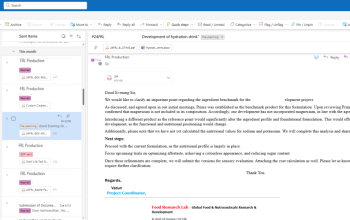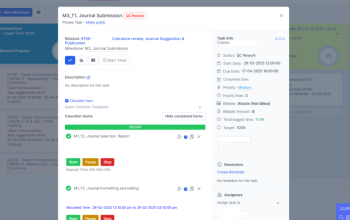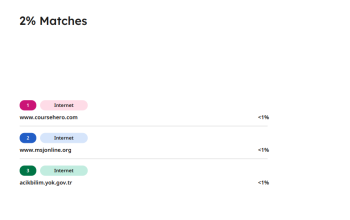PhD Sample Size Service
Get Professional Sample Size Calculation Service Through Ph.D. Assistance
Sample Size Calculation Based on Your Research Objective
For Your Research Methodology Chapter or Manuscripts
Sample Size Calculation – From Top-Class Universities Across the Globe
For Your Research Methodology Chapter or Manuscripts
Sample size determination is a very important component of designing any research. It influences the validity, reliability and generalizability of your findings. Regardless of whether it is a clinical trial, a survey, a case study, or experimental research, a suitable sample size ensures the validity of the statistical inference and the appropriateness of the research in an academic context.
Why Sample Size Calculation Matters:
Ensures Accurate Research: Eliminates anecdotal underpowered studies producing non-conclusive results and non-robust overpowered studies consuming resources.
Leads to Validity and Reliability: Adequate sample size reduces risk for error (Type I and II) and allows for consistency in findings.
Leads to Generalizability: Good choice of a sample allows research findings to be generalizable to larger population.
Ethical Research: Ensures no unnecessary data collection or participant involvement.
Approvals: Many university and journal policies require rationalisation of sample size to be included in research methodology
Challenges Faced by Ph.D. Scholars in Sample Size Calculation
Despite the above, sample size calculation represents one of the most poorly engaged and poorly developed elements in Ph.D. research proposals and final dissertation
Among issues that Ph.D. candidates have reported are the following:
1. Lack of statistical fluency Many researchers are lost in the terms effect size, power, or margin of error that are central to choosing their sample size.
2. Unclear Study Purpose An unclear or unstable research question makes it difficult to articulate the population and consequently choose the correct path for calculation.
3. Wrong Assumptions Imprecise estimates for variability, confidence level, and/or effect size can result in an inappropriate sample size.
4. Tool bewilderment Students struggle using tools (G*Power, R, SPSS) correctly to find sample size.
5. Journals or University Requirements Different institutions/journals have unique levels of rigor; different variations, and without guidance becomes daunting.
6. Time and other limitations Real world issues related to; funding, data, or any way of getting participants to act on ideal sample size directly impacts scheduling for sample sizes.
7. Justification of sample size Even if all technical calculations are appropriate, many research scholars find it hard to put a justification section in a methodology chapter or three-minute proposal defence.
Our Process is Simple & Streamlined
In an industry of academic services, we are focused on three areas of competency:
• Successful results
• Knowledge attainment
• Faster academic tempo
The process is a simple, straightforward, and transparent process that promotes workflow and assured confidentiality. We manage all our projects in the same easy steps from establishing your custom sample to the report delivery. You will also be in contact with experts in that domain of your subject matter and they will always be 'in your corner' during the project sampling period.
Ph.D. Sample Size Calculation & Power Analysis Services Include:
We will provide the appropriate sample sizes based on basic or advanced statistical principles based on your study purpose. Services we will provide:
Types of Power Analysis:
• Prior Power Analysis - necessary for thinking about the best sample size for your study, completed prior to study
• Post-hoc Power Analysis - for looking at the statistical power, completed after study
• Sensitivity & Assurance Analysis - suitable for complex designs and small samples sizes.
Core Statistical Parameters Considered:
• Alpha (α) - Type I error (false positive)
• Beta (β) - Type II error (false negative)
• Effect size - strength of the relationship between the variables
• Level of confidence - 95% fee typically, or university specific
• Level of precision (sampling error) - ±5% (i.e. margin of error)
• Degree of variability - There would be variability within the sample based on how homogeneous or heterogeneous the population was.
• You will communicate with us and we will use standard industry tools like g*power, R, SPSS, STATA and similar to conduct the sample size analyses using appropriate statistical methods.
How We Help at Ph.D. Assistance:
• Scientific, tool-based calculations for g*power R, SPSS, etc.
• Expert guidance with justification write-ups, using university or journal standards
• Clear justifications of assumptions (effect size, power, etc.)
• One-on-one help and revisions until the application is approved.
✅ A properly calculated sample size is not only a number -- sample size is the basis of credible, publishable, impactful research
We guarantee the accuracy of your sample size as it relates to the highest statistics standards. All sample size analysis is double checked and validated to confirm that it meets your research objectives, providing you with the assurance that your study is statistically valid and academically sound
All our works are completely original crafted by experts on the domain such as
- Computer Science & AI
- Law & Public Policy
- Social Sciences
- Engineering
- Life Sciences
- Medicine & Clinical Research
- Management & Finance
- Philosophy & Humanities
Our area-specific experts such as industry researchers, university professors, and licenced physicians make sure the depth and accuracy of every project that we undertake.
We will ensure that your sample size calculations conform with the parameters set out by your institution in terms of study design, statistical procedures, and reporting. Whether your study is in the IITs, Oxford, Harvard or any other UGC recognized institution, our sample size process will meet your university criteria, academic criteria, and formatting, if included.
Our researchers use peer-reviewed journals and credible academic sources from:
- Scopus
- PubMed
- IEEE Xplore
- JSTOR
- Springer
- Elsevier
- ProQuest
- Web of Science
We ensure every reference is traceable, current, and cited accurately in the required referencing style (APA, MLA, Harvard, Chicago, Oxford, Vancouver, etc.).
Our team includes:
- Writers with years of experience on the domain
- Editors with knowledge of English grammar and domain expertise.
- Proofreaders trained in grammar and consistency.
We provide unlimited revisions to address your university feedback.
Whether it’s editing a literature review or methodology reworking or improving suggestions, and our team will work until the client satisfied.
We use the most recent versions of APA, MLA, Harvard, Chicago, and Vancouver citation styles. Our work is properly cited, bibliography and all, and in line with university codes on ethics. Tools for citation management employed are Mendeley, Zotero, and EndNote.
We offer biostatistics, econometrics, and data analytics services employing tools such as:
- STATA
- R
- AMOS
- NVivo
- MATLAB
- SPSS
We support you with data cleaning, sample size calculation, hypothesis testing, all done by expert statistical analysts and PhD scholars.
Each project is completed by the dedicated schedule. We offer:
- Minor revisions in 24 hours.
- Major revisions in 48 hours.
• Fast communication (30-minute responses during business hours)
We maintain word counts as required by the university (8,000–80,000+ words), excluding non-content areas such as references, appendices, tables, and figures. No filler content—just intense, academic writing.
We provide complete transparency by sharing all study sources:
- Journal articles
- PDFs and reports
- Datasets
- Lecture notes
- Translated works
- YouTube academic links
- PPTs, legal documents, and more
These help you prepare for viva-voce, future publications, or further coursework.
Our Sample Size Service by Subject Area
Sample Size Calculations We Perform
Cochran’s Formula
Service: We determine the sample size needed to estimate proportions at a specified level of confidence and specified margin of error. Good for research that uses categorical data (and proportions).
Output: The sample size estimate and adequate documentation on margin of error and confidence level.
Support: We help you interpret the sample size estimate and what it means for your study.
Sample Size for Proportions with Two Groups
Service: We achieve our sample size to compare proportions of two groups, and we will provide sample size estimation that accounts for requested power and significance level, along with the variation in the margin of error or confidence interval under the specified significance level.
Output: The estimated sample size that has factored in the proportions for the two groups and our recommendation on changes to the study design, if you prefer.
Support: We provide input on the interpretation of your sample size estimation with respect to your study specific issues along with input to change your study design.
Finite Population Correction
Service: If you are studying a finite population (e.g. very small, localized groups), we can provide a result with some adjustment for the sample size calculations should the population size be relevant and to be accurate.
Output: Sample size estimates correcting for population size and/or sampling method.
Support: We support you through making the necessary changes in using finite populations when estimating your study results precision with conducting a study in a finite population.
Sample Size for Mean
Service: We provide sample size estimations based on studies estimating population means (such as study average test scores, measurements) based on desired level of confidence and margin of error.
Output: Sample size estimations that include details such as the population standard deviation you guess, and the level of confidence.
Support: We assist in understanding the reliability of your study estimates, and the impact of sample size on quality of estimate.
Sample Size for Regression
Service: We will provide a sample size needed for studies using regression models (e.g., linear regression, logistic regression) based on the number of predictor variables to be included, desired power, and effect size.
Output: We will provide sample size estimation that has factored in the predictor variable(s) and model assumptions for the regression.
Support: We provide discussion on the power of your regression model to detect a significant relationship and changes to study design.
Cluster Sampling
Service: If your study uses cluster sampling (for example: either school, hospitals, regions), we will provide sample size calculations using cluster sampling protocols and applying adjustments for intra-cluster correlation, and accounting for the cluster design.
Output: Sample size estimation for a cluster sampling data based on intra-cluster correlation.
Support: We will help you to design the study using cluster sampling and we will ensure you understand the impact that using clustering has on your sample size.
Sample Size for Difference in Means
Power Analysis
Service: A power analysis gives you insight into the potential for your study participants to generally indicate a meaningful impact that you will likely observe (power) and also helps to determine a sample size estimate from your likely effect sizes/expected power levels.
Output: The power analysis results, indicating a suggested sample size, expected effect size, and power (e.g. 80%, 90%).
Support: We can help you to use power analysis to assess whether your study was powered appropriately and provide guidance/ideas if changes are needed to help your conclusions be more trustworthy.
Bayesian Methods
Service: We will deliver sample size calculations using Bayesian sample size estimation to include prior distribution(s) and if applicable update this sample size calculations with additional data.
Output: Sample size estimation of the Bayesian prior and posterior distributions.
Support: We will help you to understand the implications of sample size estimating using Bayesian methods and when and how you could use Bayesian methods in the design of a study.
Order process
Step 1:
Submit Your Requirements and Make Payment
You will need to complete an order form collecting the necessary detail (i.e., title of study, study goals and objectives, study design, population of interest, and anticipated result) about your study. Once you complete your order form requires, you will complete a secure online payment to get started on your ordered project.
Step 2:
Order Confirmation & Expert Allocation
Once your payment has been processed, you will receive an official order receipt. After receipt of payment, a suitably qualified biostatistician or research methodology expert will be applied to your project in regard to the area of research you are studying, and the type of study done.
Step 3:
Regular Updates & Two-Way Communication
Our team will provide you with continual updates to your research project. In the event you receive any new feedback or direction from a supervisor or ethics guidance document, this can be uploaded directly to us, to ensure we are aware of it in relation to undertaking your work.
Step 4:
Sample Size Calculation & Justification
The statistical expert will find the proper sample size based on appropriate statistical formulas and software (G*Power, OpenEpi, STATA, SPSS). We will write paragraphs with a detailed overview of the chosen sample size along with describing all the assumptions that were focused upon and the method used to base on your study design and parameters.
Step 5:
Review & Revisions
The document will be reviewed thoroughly. We provide unlimited free revision to comply with supervisor or reviewer recommendations until you are completely satisfied and nothing is left undone.
Step 6:
Final Delivery & Feedback
The final sample size report (including any calculations and references will be emailed and delivered through the CRM. We welcome any feedback to enhance and better our services.
Sample Size Calculation – Service Package
Accurate. Defensible. Aligned with Your Research Objectives.
- Our understanding of your research goal
- Discuss the research methodology (qualitative/quantitative/mixed)
- What design did you identify for your study (e.g. cross-sectional, experimental)
- Find the most appropriate formula/model
- Use a tool: G*Power, SPSS, STATA or R
- We will factor in:
- Confidence level (e.g. 95% confidence level)
- Error margin (e.g. ±5%)
- Effect size
- Power (e.g. 0.80 or 80%)
- Population size
- Type I or Type II error rates
- Prior Power Analysis: Identifying, based on data, how large of a sample before data collection is needed.
- What are you able to say about sampling error
- How much population variability are you dealing with
- Appropriate confidence intervals?
- Completed written incorporation for sample size portion
- With rationale supported by literature
- Attentive to the standards of universities (APA, MLA, Harvard on etc).
- If I wish I can revise text in line with supervisor's recommendations; and
- Improving the language and statistical explanations.
- Complete Power Analysis Report (Graphical outputs + interpretation)
- Sampling Frame Design
- Full Methodology chapter development
- Changing from probability to non-probability methods
Turnaround Time:
Standard: 5-7 working days
Expedited: 3 working days (add-on)
Who Is This For?
- Ph.D. scholars developing research proposals or thesis
- Researchers submitting to peer-reviewed journals
- Master's students writing their dissertation
- Practitioners conducting academic or applied research
Types of Study Data for Sample Size Calculation at PhD Assistance Research Lab
Key Features: Data that can take on any value on a continuum generally measured on an interval or ratio scale (e.g. height, weight, test scores).
Best for: Sample size calculations for studies that estimate means or for regression analysis; used in all research areas, especially health sciences, social sciences, and education.
Key Features: Data in distinct categories without any meaningful order (e.g. gender, race, yes/no).
Best for: Sample size calculations for hypothesis testing for proportions (epidemiological studies, social science studies).
Key Characteristics: Data that measures the time to an event (e.g. the time to survive, the time to failure); commonly involves censoring.
Best for: Sample size planning for survival analysis for clinical trials or longitudinal health studies; obviously most frequent area of research is for disease outcomes or treatment effectiveness studies.
Key Features: Data that includes multiple dependent variables that may be analysed to understand the relationship between the predictor(s) and an outcome (regression, factor analysis, PCA)
Best For: Sample size calculation on complex models that use multivariate techniques, such as regression, factor analysis and multivariate analysis. Particularly useful in bioinformatics, economics and social sciences.
Key Features: Data that has been collected on the same subject over multiple time points, and it is most useful in evaluating trends, and changes in subjects over time.
Best For: Sample size estimation for studies where subjects are measured repetitively, or the goal is to see/change/evaluate change over time. Commonly applies in public health program work, and improvement studies in health care.
Key Features: Data that is collected at one point in time to evaluate the prevalence of something or to describe the characteristics of certain population (surveys).
Best For: Sample size calculation for descriptive studies or prevalence studies. Commonly used in market research, health assessments, demographic studies and health assessments.
Whom We Serve – Sample Size Service for your Research
PhD Assistance Research Lab offers sample size calculation services to a variety of clients in the academic, research, and corporate landscapes. We serve the needs of stakeholders who engage in research endeavours and are planning and executing statistically sound research projects.
If you are a PhD candidate or doctoral researcher conducting quantitative research, we can help ensure your research is statistically powered. We provide study design support from beginning to end, including determining what sample size calculation method your research needs to the subsequent inferential analysis (e.g., ANOVA, regression, survival analysis).
We partner with universities, research councils, and academic programs to improve the academic rigor of their research projects. All our sample size estimation services can be done in accordance with all university academic integrity policies and institutional ethics and ensure that any research will be based on sound methodology and be adequately powered for academic and publication quality.
For post-doctoral researchers, independent researchers, and an academic author, we provide statistical support for fields like medicine, psychology, education, engineering, among others. We can help with
Sample Size Estimation for Your Research: We can estimate sample size for both ditsy and complex programs.
We help healthcare professionals and health research experts determine the optimal sample size for clinical trials, studies of health outcomes and studies in epidemiology. Our services include:
Power analysis in clinical research: We check to see if your study is adequately powered to find statistically significant effects that are meaningful from a clinical perspective.
Sample Size Estimation for patient-centered research: We can provide sample size estimation which is suited for health systems research, decision-making studies, and patient experience research.
For corporate R&D teams who are involved with research in biostatistics, we offer practical solutions for you to get usable final sample size estimations. Whether you are developing a product, studying a user experience, or analysing organizational data, we can help with:
Sample Size Estimates for Product Testing: Making sure that your research on some product’s impact or user satisfaction is statistically valid.
Survey and Focus Group Research: Helping you calculate the sample size to meaningfully inform your business.
We assist students and researchers from anywhere in the world, including UK, US, Australia, UAE, India, and Europe. Our services meet international academic requirements, including:
Region-specific software support: whether you use NVivo (UK/AUS), MAXQDA (Germany/EU) or other region-specific software tool(s), we will ensure agreed sample size calculations apply within your software environment.
Check at what stage you’re into & Analyse how you can fit into our engagement model
Matteo

Sample Size justification and ethical compliance We will write-up how you calculated your sample size, including assumptions, readings of the formula, and references to previous research documentation. The requested justification complies with ethics and would allow you to reasonably present your proposal to ethics board, funding aspects or academic reviewers.
Sofia

Sample Size Estimation & Reporting We assist you with estimating the appropriate sample size for your study by aggregating all parameters of your study which includes the population size, estimated effect size, confidence level, power, and margin of error. Using our expertise, we will verify that the sample size is appropriately estimated within your study design whether the study is observational, experimental or survey.
Elena

Sample Size Adjustment considering Dropouts We will be able to assist you in adjusting the sample size to consider dropouts, non-response rates, or lost to follow up. We provide adjustments to samples with rationales so the final, sample selection will be adequate robustness to produce valid and generalizable results.
Daniel

Documentation of Assumptions and Software Based Calculation We will document all the statistical assumptions (expected proportions, standard deviation and effect size) you used and will provide the output based on the software you employed, such as G*Power, OpenEpi or STATA. Your rationales and transparent documentation will go into your Graduate thesis or Journal articles.
Our Guarantee

Plagiarism Free

Unlimited Support

On-time delivery

Subject Matter Expertise

Communicate with your writer

Updated academic resources

Free research articles supply*
Our Sample & Example Works Speaks
Client success stories
Sample Size Service
Expert Guidance on Sample Size Planning

"I was unsure of how many participants I needed for my cross-sectional study research. The PhD Assistance Research Lab provided all the statistical theory on how to calculate a sample size, based on power, the level of significance and effect size. Plus, after I received their expert input, I felt much more confident in my research design."
— Sophie Laurent, France, PhD Student
Fast Turnaround for Ethics Submission

"I was just coming up to the cut-off date for submission for proper ethical review and didn't have the sample size calculated yet. The team at the PhD Assistance Research Lab calculated everything and wrote the justification in two days - including G*Power output and rationale. They were absolutely reliable."
— Jonas Weber, Doctorate Candidate, Germany
Accurate Calculation with Clear Justification

“I decided to choose the premium sample size service. I received the numbers from the PhD Assistance Research Lab with a detailed explanation of the assumptions, variables and statistical model. This section on the justification was very important to justify my methodology to my review board.”
— Isabella Rossi, Medical Researcher, Italy
Ready-Made Documentation for Proposal

"The documentation was made to the exact specifications of my university's requirements. Everything was included- formulas, software outputs, assumptions as well as revised figures for non-response. The amount of work saved was well worth it and the work product was very professional!"
- Erik Lindholm, Data Analyst, Swede
Validation of Assumptions and Transparency in Methods

"I wanted to be assured my sample size was not just a random number. The team evaluated my study plan carefully and led me through the assumptions, such as expected effect size, standard deviation and dropout rates. The process applied scientific rigor and was transparent."
— Marta Novak, PhD Candidate in Epidemiology, Poland
Affordable Pricing"

“I fully admire PhD assistance's reputation and quality. I especially chose PhD assistance's packages as no other company offers such a service. Their service quality and timely delivery is very helpful in meeting journal deadlines. I am glad that PhD assistance offers packages at affordable price.”
-Kate Merkel-Hess
Supportive brainstorming and topic discovery

"Picking a topic for my PhD felt like looking for a needle in a haystack. I was lost until I found the topic selection guidance service at PhD Assistance. They were like personal academic cheerleaders—helping me discover what I truly cared about and could research meaningfully. It was like a brainstorming session with friends who knew their stuff. Now I’m excited to dive into my research and make a difference!"
PhD topic clarity and direction

"Choosing a PhD topic was a total headache until I stumbled upon the PhD Thesis Dissertation Topics Help UK at PhD Assistance. Let me tell you—these guys are wizards when it comes to turning confusion into clarity. They didn’t just throw random ideas at me; they took the time to understand what I was passionate about and what I wanted to achieve. It felt like having a coffee chat with a smart friend who knows all about PhDs. Thanks to their help, I finally feel like I’m on the right track and ready to tackle anything that comes my way!"
Stress-free topic selection in Computer Science

"I was very confused about selecting a research topic for my PhD in computer science. It was stressful and overwhelming. A friend recommended PhD Assistance—and it was the best decision. The expert helped me choose a topic that my guide accepted without any changes. Thank you, PhD Assistance!"
Confidence-building experience

"I recommend PhD Assistance to anyone needing help with research topic selection. I was hesitant at first, but after meeting the team, I gained confidence in articulating my ideas clearly. The title they provided matched exactly what I had in mind—it felt like they had read my thoughts. Thank you!"
Structured support for academic success

"I was feeling overwhelmed and lost when it came to choosing a PhD topic that would truly excite me and contribute to the field. Thankfully, the topic selection service at PhD Assistance gave me invaluable support. They took the time to understand my interests, strengths, and goals and curated a list of focused research areas. I found a topic that reignited my passion. Thank you, team!"
John, France
Flexible and student-friendly service

"PhD Assistance offered me great flexibility in choosing courses and research areas. The specialists helped me identify a unique and meaningful topic. It gave me a strong foundation to move confidently into the next stage of my research."
Liam
Supportive brainstorming and topic discovery

"Picking a topic for my PhD felt like looking for a needle in a haystack. I was lost until I found the topic selection guidance service at PhD Assistance. They were like personal academic cheerleaders—helping me discover what I truly cared about and could research meaningfully. It was like a brainstorming session with friends who knew their stuff. Now I’m excited to dive into my research and make a difference!"
Supportive brainstorming and topic discovery

"Picking a topic for my PhD felt like looking for a needle in a haystack. I was lost until I found the topic selection guidance service at PhD Assistance. They were like personal academic cheerleaders—helping me discover what I truly cared about and could research meaningfully. It was like a brainstorming session with friends who knew their stuff. Now I’m excited to dive into my research and make a difference!"
Quality & Compliances
We’ve worked on so many great PhD projects for our clients across the globe, and we’re proud of every single task that we carry out



Frequently Asked Questions.
Yes, you may communicate with our academicians via company Skype, mail, WhatsApp chat messages and call. In fact, you may directly speak to the given writers once an appointment is set with our project coordinators and make all arrangements for you.
We provide following features at PhD Assistance Research Lab in sample size service.
There are different types of power analysis:
- Prior power analysis – This analysis is implemented before the study is conducted
- Post-hoc power analysis –This analysis is executed after the study is conducted
In this analysis, three major factors like sample size, alpha, beta and effect size can be calculated.
- Alpha (α) – Rejection of the correct null hypothesis [Probability of Type I Errors]
- Beta (β) – Acceptance of a false null hypothesis [Probability of Type II Errors]
Effect size – Measure of the strength of the relationship between two variables
Further, we also look out for the Level of Precision- sampling error
range – the true value of the population estimated to be.
Expressed in percentage points (e.g., ±5 percent).
Degree of Variability
- The distribution of attributes the more heterogeneous a population, the larger the sample size while the less variable (more homogenous), the smaller the sample size
- Approached to determine the size of your sample
- We aim at building dissertation service standards for others to follow.
Statistical sample size calculation mainly helps to generate how much sample/data needed to make an accurate decision on research. Sample size calculations can help you determine how large sample size you need to create to achieve accurate statistical outcomes. The purpose of power analysis and sample size calculation is to determine if you will have enough power and determining the appropriate sample size, hence, utilizing too large (may waste money, resources and time) or too small (inaccurate result) may be avoided. Without sample calculations, you will not be assured that if your proposed sample size is too large or small.
For example, when comparing two-target population and reached a sample size less than 30, we use one of the statistical analysis test /power analyses –T-test. Similarly, if the sample size is >30, then we utilize the z-test. In general, if the targeted population size is smaller one, then we use a bigger sample size, and if the targeted population size is larger one, we require a smaller sample size. In addition, sample size calculation would also differ with different margins of errors.
Ph.D. Assistance statistician, expert in sample size calculations, will apply the various statistical techniques and formulas to get accurate sample size calculations. There are numerous sample size calculations, but it varies from one technique to another. However, Ph.D. Methodology experts at Ph.D. Assistance, look at several criteria, while determining the appropriate sample size for your study.
- Level of precision
- Level of confidence or risk
- Degree of variability in the attributes being measured (prevalence)
- External validity
Pricing by Ph.D. Assistance Research Lab is fair as compared to others, but the quality of the writing is unbeatable. We also facilitate seasonal discount plan, and referral offers for our customers. Please contact our project coordinators for further information.
No. We are not charging extra amount for any revision of the document. We do any numbers of revisions until our customers get satisfied. To know more details about revisions and other inquiries. Please feel free to conduct our project coordinators or request a call back on the website to get the call back from experts. You may also please read our terms and conditions while placing an order.
Sure, we will assist you. If you are searching for the courses or onsite/offsite tutor to get knowledge of how to write a dissertation, then contact us or Request call back. When you take our services, we will give you professionally and researcher who will assist to teach or train you to divide every step of the dissertation writing into manageable parts.
Insights

A Proper Research Manuscript Writing Paper must have a good topic,…











